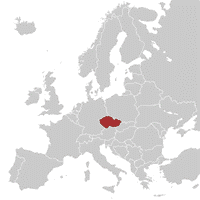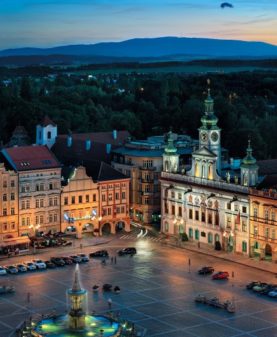 The Czech Republic is and inland country situated in Central Europe. It is one of five safest countries in the world. The neighbouring countries are Germany in the west, Poland in the north, Slovakia in the East and Austria in the south.
The Czech Republic is and inland country situated in Central Europe. It is one of five safest countries in the world. The neighbouring countries are Germany in the west, Poland in the north, Slovakia in the East and Austria in the south.
The Czech Republic is a modern and democratic country with a rich culture and history.
- Foundation: 1 January, 1993
- Area: 78,867 km2
- CR consists of three historical countries – Bohemia, Moravia, Silesia.
 Capital: Prague
Capital: Prague- Population: 10 446 157
- Official language: Czech
- Currency: 1 Czech crown (CZK)
- Time zone: Central European Time (C.E.T.) / Greenwich mean time (GMT + 1), summer time – Greenwich mean time + 1 (GMT + 2)
- Religion: no religion 59 %, Roman-Catholic 27 %
- Political system: democratic parliamentary republic
- Member of NATO: since 12 March, 1999
- Member of European Union: since 1 May, 2004
History
 The history of the independent Czech state dates back to the second half of the 9th century. However, the territory was settled back in the Stone Age.
The history of the independent Czech state dates back to the second half of the 9th century. However, the territory was settled back in the Stone Age.- Between the 9th and 13th century, Czech lands are ruled by the Přemyslid dynasty. At the beginning of the 13th century, Duchy of Bohemia was raised to a kingdom.
 Czech lands reach the greatest flourishing in the 14th century, under the reign of Czech king and Roman emperor, Charles IV. During his reign, Czech lands experienced the biggest flourishment, and Prague becomes one of the most important European cities.
Czech lands reach the greatest flourishing in the 14th century, under the reign of Czech king and Roman emperor, Charles IV. During his reign, Czech lands experienced the biggest flourishment, and Prague becomes one of the most important European cities.- Between 1526 and 1918, Czech lands became a part of Austrian monarchy and the House of Habsburg assumed the Czech throne. The most significant Habsburg king is considered Roman emperor Rudolph II.
- At the end of the World War I, 28 October 1918, Lands of the Bohemian Crowned joined to the territory of the present-day Slovak Republic to create the Czechoslovak Republic. During the 40-year-long communist regime, which started in 1948, the name of the Czech Republic was changed into Czechoslovak Socialistic Republic.
- After so-called Velvet revolution in 1989, which finished the totalitarian regime, the name of the state changed again to Czech and Slovak Federative Republic.
In January 1993, the Republic split into two independent states – Czech Republic and Slovak Republic. Nowadays, the Czech Republic is a modern and democratic country with rich culture and history.
